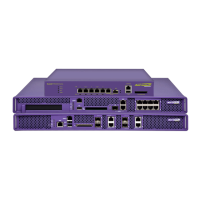Summit WM3000 Series Controller System Reference Guide 201
6 Selecting a radio from the table will display the following details of individual calls:
7 Click on the Show Filtering Options link to set filtering parameters to filter information displayed on
the screen. Once the Show Filtering Options link is selected, the Filter Option Zone which allows the
selection of filtering parameters is displayed. Up to two parameters may be selected.
Within the Filter Option Zone the following options are presented:
Description
Displays the names assigned to each of the APs. The AP name can be
configured on the Access Point Radios Configuration page.
Type
Displays the radio type of the corresponding APs. Available type are:
• 802.11a
• 802.11an
• 802.11bg
• 802.11bgn
Calls per radio
(Current)
Displays the current number of active voice calls for each Access Point.
Calls per radio (Max)
Displays the maximum number of concurrent voice calls that each Access
Point has seen.
Calls per radio (Avg)
Displays an average number of calls active on each Access Point.
Packets Dropped (%)
Displays a percentage of the packets that each Access Point has dropped
in comparison to the total number of packets.
Packets Dropped
Displays the total number of packets dropped by each Access Point.
Delay to AP
Displays the current delay time for each Access Point.
MUs Associated
Displays the total number of mobile units associated with each Access
Point.
Index
Displays the numerical identifier assigned to each MU.
Protocol
Displays which voice protocol is being used for the selected call. Voice
protocols include:
• Spectralink
• H.323
Successful Calls
Displays the number of successful calls for the displayed MUs.
Avg Call Quality
R Factor
Displays the average call quality using the R Factor scale. The R Factor
method rates voice quality on a scale of 0 to 120 with a higher score
being better. If the R Factor score is lower than 70 it is likely users will
not be satisfied with the voice quality of calls.
Avg Call Quality
MOS-CQ
Displays the average call quality using the Mean Opinion Score (MOS)
call quality scale. The MOS scale rates call quality on a scale of 1-5 with
higher scores being better. If the MOS score is lower than 3.5 it is likely
that users will not be satisfied with the voice quality of calls.
Average Jitter
(msec)
Displays the average jitter time for calls on the displayed MUs. Jitter is
delays on the network that can result in a lag in conversations. A jitter
score higher than 150ms is likely to be noticed by end users during a
call.
Average Latency
(msec)
Displays the average latency in miliseconds for calls on the selected MUs.

